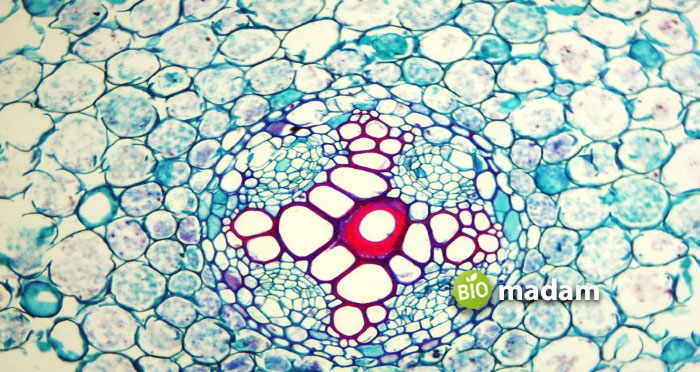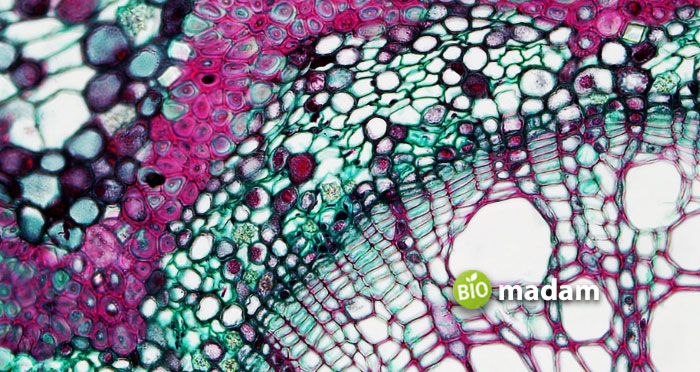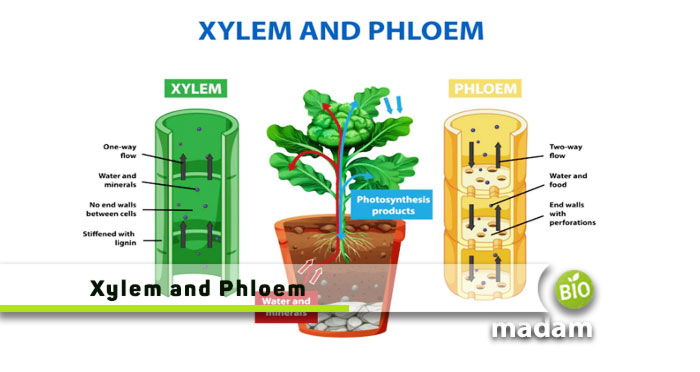Recently updated on October 4th, 2023 at 10:57 am
Scientists have found around 500,000 species of numerous genera of plants, with 40% rare species. They constitute multiple families and genres comprising vascular and non-vascular plants. Vascular plants make up 260,000 of the total plants on Earth. Xylem and phloem are important components of vascular plants. They are involved in the transport of materials in these plants. Xylem carries water and nutrients to shoots and leaves. On the other hand, phloem distributes organic nutrients.
Keep reading to learn the differences between xylem and phloem in detail.
Comparison Table
| Characteristics | Xylem | Phloem |
| Origin | Xylon | Pholoios |
| Literal Meaning | Wood | Bark |
| Function | Water transport | Organic material transport |
| Direction | Unidirectional | Bidirectional |
| Components | Tracheids, xylem fibers, xylem parenchyma, & vessels | Phloem parenchyma, sieve tubes, companion cells & phloem fibers |
| Types | Primary and secondary | Protophloem and metaphloem |
| Shape | Star-shaped | Tubular |
| Cell Type | Dead cells | Living cells |
| Transport Type | Passive | Active |
| Position | Center | Outer side |
| Tissue Volume | High | Low |
| Mechanical Support | Yes | No |
What is Xylem?
Xylem tissues in plants transport water and nutrients from the roots to other parts.
The word xylem comes from “Xylon,” meaning wood. It refers to the hard, complex tissue in the plant that carries water and sap. The transport helps move water, minerals, and salt from the root to the top region of the plant. The process is unidirectional and does not require any external energy. Xylem becomes stiff as the plant grows and develops into the wood.
Parts of Xylem
Unlike collenchyma, sclerenchyma and parenchyma together form different components of the xylem. They contain important organic compounds like proteins and lipids. Parenchyma is living, whereas sclerenchyma is non-living. The components of xylem are:
Tracheids
Tracheids are widely known as the fundamental unit of the xylem. They are elongated tube-like cells tapered at the end containing lignified cell walls. Tracheids could be spiral, annular, pitted, reticulate or scalariform.
Xylem Fibers
The second part of the xylem tissue is xylem fibers or wood fibers. They comprise dead sclerenchymatous tissues in the form of long fibers that provide mechanical support to the plant.
Xylem Parenchyma
Xylem parenchyma are the living cells in the xylem tissue that help conduct water over short distances. They are also used in the storage of food in the form of carbohydrates.
Vessels
Vessels are also critical parts of the xylem tissue. They are interconnected and possess holes to allow the movement of material. Vessels have a cylindrical and tube-like shape with lignin walls. However, these vessels are not too thick and have round edges. They are also called Tracheae.

Types of Xylem
Xylem is mainly divided into two types: primary and secondary xylem. The categorization is based on the growth stage of the plant. Let’s tell you more about them.
Primary Xylem
Primary xylem is produced during the plant’s primary growth to transport water and sap in the young plant. They are present in the tips of roots and shoots and help elongate the plant.
Secondary Xylem
Just like primary xylem is involved in the primary growth, the secondary xylem increases the width of the plant during secondary growth. Consequently, they contribute to the growth of the plant. They lead to dark rings in the tree’s trunk that specify the age of the trees. They are common in angiosperms and gymnosperms.
What is Phloem?
Phloem is the permanent tissue in a plant contributing to the transport of organic material in the plant.
The word phloem comes from “Pholoios,” meaning bark. Phloem is the component of vascular plants that facilitates the conduction of micro and macronutrients required for growth. It ensures uniform distribution of organic material produced as a result of photosynthesis. The process of food transport in the plant is known as translocation.
Parts of Phloem
Phloem comprises four primary components called phloem parenchyma, companion cells, sieve tubes, and phloem fibers.
Phloem Parenchyma
Phloem parenchyma is not present in most monocots and dicots. It grows with sieve tubes and companion cells. Their major function is the storage of food which is later translocated to different parts of the plant.
Companion Cells
Companion cells are connected to the sieve tubes on the outer surface. They are elongated and thin-walled living cells and possess a big nucleus for multiple functions. Companion cells are present in angiosperms and absent in all types of gymnosperms and pteridophytes.
Sieve Tubes
Sieve tubes have a thin continuous cytoplasm between two adjoining cells. They are living cells but do not contain a nucleus. Sieve tubes form conducting channels that rest on each other in an elongated pattern.
Phloem Fibers
Like xylem fibers, vascular tissues also contain phloem fibers. They comprise sclerenchymatous cells with a fiber-like appearance and lignified cell walls. Phloem fibers have a significant contribution to strengthening the tissues and supporting transport.

Types of Phloem
Phloem is also of two types similar to the xylem. However, they are categorized as protophloem and metaphloem.
Protophloem
Protophloem develops in the initial growth spur of the plant and may contain single or grouped anucleate sieve elements. Companion cells may or may not be a part of protophloem.
Metaphloem
On the contrary, metaphloem grows when plant enlargement stops. The parenchyma cells eventually become sclereids while the sieve components elongate. Furthermore, companion cells are present in metaphloem.
Similarities Between Xylem and Phloem
- Xylem and phloem are present in vascular plants.
- They are involved in the transport of materials in the plant.
- Both contain parenchymatous cells.
- Their cell walls are made of cellulose.
Differences Between Xylem and Phloem
Origin
Xylem
The term xylem originates from “Xylon,” which means ‘wood’.
Phloem
On the other hand, phloem comes from the Greek word Pholoios, meaning ‘bark.’
Function
Xylem
Xylem contributes to the transport of water from the roots of the plant to the shoots and leaves.
Phloem
Whereas phloem is responsible for the transport of organic material produced as a result of photosynthesis.
Direction
Xylem
Water and nutrients reach the top region of the plant through unidirectional movement.
Phloem
Contrarily, phloem offers bidirectional transport throughout the plant for material transport.
Components
Xylem
The xylem is made up of tracheids, vessels, xylem fibers, and xylem parenchyma.
Phloem
At the same time, the phloem comprises four primary components called phloem parenchyma, companion cells, sieve tubes, and phloem fibers.
Types
Xylem
Xylem in vascular plants is of two types: primary xylem and secondary xylem.
Phloem
In contrast, phloem is categorized into protophloem and metaphloem.
Shape
Xylem
The xylem is considered to be a star-shaped vascular tissue.
Phloem
However, the phloem possesses a tubular shape.
Cell Type
Xylem
Xylem majorly comprises dead cells except for xylem parenchyma cells.
Phloem
Whereas, phloem is primarily composed of living cells.
Type of Transport
Xylem
Xylem carries out the transport of water and nutrients through passive transport.
Phloem
However, the phloem distributes organic material throughout the plant body by active transport.
Position in Vascular Bundle
Xylem
It is present in the center of the vascular bundle towards the upper epidermis.
Phloem
While phloem is present on the outer side of the vascular bundle towards the lower epidermis.
Tissue Volume
Xylem
The xylem contains a higher amount of tissues in the plant body.
Phloem
Meanwhile, the number of phloem tissues in plants is comparatively less.
Mechanical Support
Xylem
Xylem is also known as wood and provides mechanical support to the plant as it grows.
Phloem
On the contrary, phloem does not provide any mechanical support to the plant.
The Bottom Line
Xylem and phloem are essential components of botanical and horticultural vascular plants. They enable the transport of water and carbohydrates throughout the plant. Xylem tissues carry plants and nutrients from the roots to the upper region. Alternatively, phloem transports organic compounds synthesized by the plant. Xylem also provides support to the plant structure. They are both essential to plants to carry out developmental functions.
FAQs
Why is the xylem called dead tissue?
The xylem is primarily composed of dead sclerenchyma tissues. They do not have cell organelles and only help conduct water and sap from the root to other parts of the plant.
Which cell is living in phloem?
Contrary to the xylem, phloem comprises parenchyma cells which are living cells. Only the phloem fibers are dead cells in this vascular tissue.
What is the pH of phloem?
Phloem sap has a slightly alkaline pH between 7.3 and 8.5 giving it. Alternatively, xylem pH is moderately acidic, with a pH between 5 and 6.

Hello, I would like to introduce myself to you! I am Chelsea Rogers, an experienced blog writer for science articles, holding an MPhil degree. My enthusiasm to grab the best knowledge, let it relate to botany, zoology, or any other science branch. Read my articles & let me wait for your words s in the comment section.

